Eco MITSUBISHI ECLIPSE CROSS 2019 Owner's Manual (in English)
[x] Cancel search | Manufacturer: MITSUBISHI, Model Year: 2019, Model line: ECLIPSE CROSS, Model: MITSUBISHI ECLIPSE CROSS 2019Pages: 423, PDF Size: 75.41 MB
Page 369 of 423
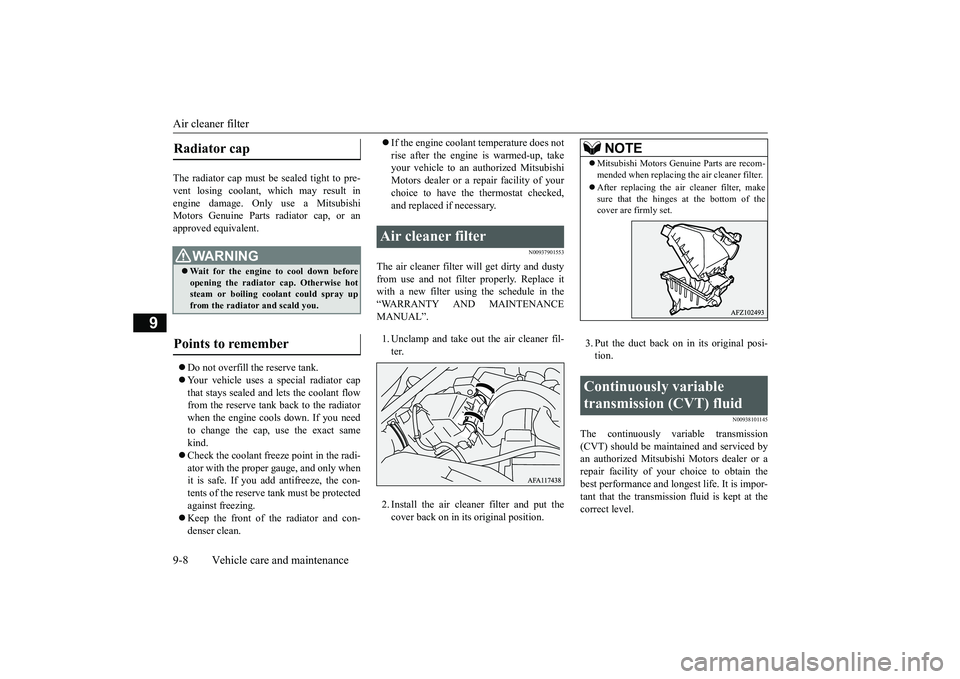
Air cleaner filter 9-8 Vehicle care and maintenance
9
The radiator cap must be
sealed tight to pre-
vent losing coolant, which may result inengine damage. Only use a Mitsubishi Motors Genuine Parts radiator cap, or an approved equivalent. Do not overfill the reserve tank. Your vehicle uses a special radiator cap that stays sealed and lets the coolant flow from the reserve tank back to the radiatorwhen the engine cools down. If you need to change the cap, use the exact same kind. Check the coolant freeze point in the radi- ator with the proper gauge, and only when it is safe. If you add antifreeze, the con-tents of the reserve tank must be protected against freezing. Keep the front of the radiator and con- denser clean.
If the engine coolant temperature does not rise after the engine is warmed-up, take your vehicle to an authorized Mitsubishi Motors dealer or a repair facility of yourchoice to have the thermostat checked, and replaced if necessary.
N00937901553
The air cleaner filter w
ill get dirty and dusty
from use and not filter properly. Replace it with a new filter using the schedule in the “WARRANTY AND MAINTENANCEMANUAL”. 1. Unclamp and take out the air cleaner fil- ter. 2. Install the air cleaner filter and put the cover back on in its original position.
3. Put the duct back on in its original posi- tion.
N00938101145
The continuously variable transmission(CVT) should be maintained and serviced by an authorized Mitsubishi Motors dealer or arepair facility of your choice to obtain the best performance and longest life. It is impor- tant that the transmission fluid is kept at thecorrect level.
Radiator cap
WA R N I N G Wait for the engine to cool down before opening the radiator cap. Otherwise hotsteam or boiling coolant could spray up from the radiator and scald you.
Points to remember
Air cleaner filter
NOTE
Mitsubishi Motors Genuine Parts are recom- mended when replacing the air cleaner filter. After replacing the air cleaner filter, make sure that the hinges at the bottom of thecover are firmly set.
Continuously variable transmission (CVT) fluid
BK0266800US.bo
ok 8 ページ 2018年6月27日 水曜日 午後5時6分
Page 370 of 423
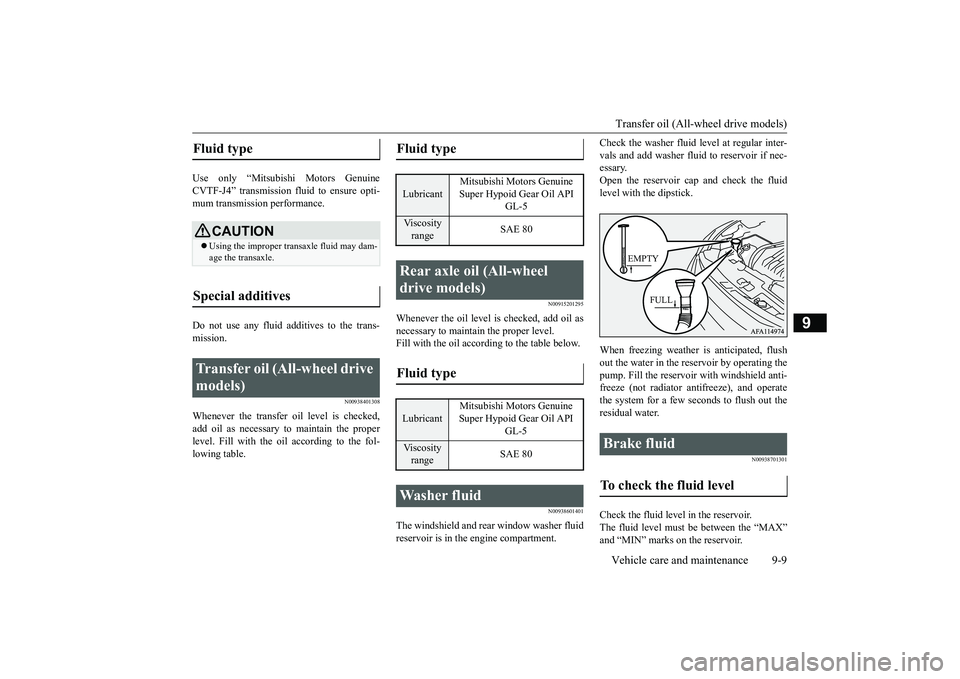
Transfer oil (All-wheel drive models) Vehicle care and maintenance 9-9
9
Use only “Mitsubishi Motors Genuine CVTF-J4” transmission fluid to ensure opti-mum transmission performance. Do not use any fluid additives to the trans- mission.
N00938401308
Whenever the transfer oil level is checked,add oil as necessary to maintain the proper level. Fill with the oil according to the fol-lowing table.
N00915201295
Whenever the oil level is checked, add oil asnecessary to maintain the proper level.Fill with the oil according to the table below.
N00938601401
The windshield and rear window washer fluid reservoir is in the engine compartment.
Check the washer fluid level at regular inter- vals and add washer fluid to reservoir if nec- essary. Open the reservoir cap and check the fluidlevel with the dipstick. When freezing weather is anticipated, flush out the water in the reservoir by operating thepump. Fill the reservoir with windshield anti-freeze (not radiator antifreeze), and operate the system for a few seconds to flush out the residual water.
N00938701301
Check the fluid level in the reservoir.The fluid level must be between the “MAX”and “MIN” marks on the reservoir.
Fluid type
CAUTION Using the improper transaxle fluid may dam- age the transaxle.
Special additives Transfer oil (All-wheel drive models)
Fluid type Lubricant
Mitsubishi Motors Genuine Super Hypoid Gear Oil API
GL-5
Viscosity range
SAE 80
Rear axle oil (All-wheel drive models) Fluid type Lubricant
Mitsubishi Motors Genuine Super Hypoid Gear Oil API
GL-5
Viscosity range
SAE 80
Washer fluid
Brake fluid To check the fluid level
FULL
EMPTY
BK0266800US.bo
ok 9 ページ 2018年6月27日 水曜日 午後5時6分
Page 371 of 423
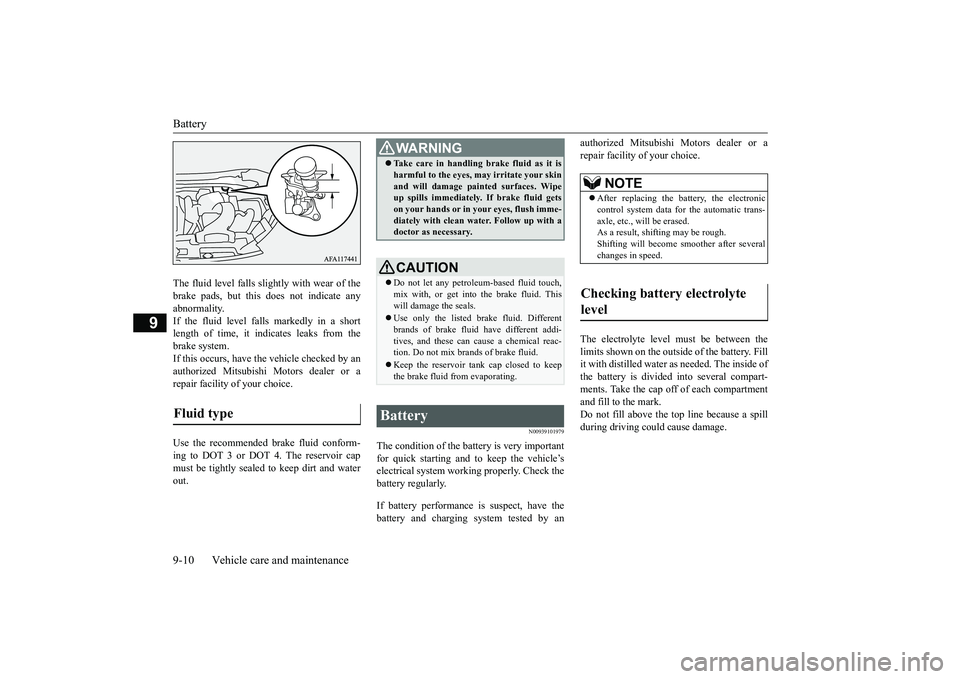
Battery 9-10 Vehicle care and maintenance
9
The fluid level falls slightly with wear of the brake pads, but this does not indicate anyabnormality. If the fluid level falls markedly in a short length of time, it indicates leaks from thebrake system. If this occurs, have the vehicle checked by an authorized Mitsubishi Motors dealer or arepair facility of your choice. Use the recommended brake fluid conform- ing to DOT 3 or DOT 4. The reservoir capmust be tightly sealed to keep dirt and water out.
N00939101979
The condition of the battery is very important for quick starting and to keep the vehicle’selectrical system working properly. Check the battery regularly. If battery performance is suspect, have the battery and charging system tested by an
authorized Mitsubishi Motors dealer or a repair facility of your choice. The electrolyte level must be between the limits shown on the outside of the battery. Fill it with distilled water as needed. The inside ofthe battery is divided into several compart- ments. Take the cap off of each compartment and fill to the mark.Do not fill above the top line because a spill during driving could cause damage.
Fluid type
WA R N I N G Take care in handling brake fluid as it is harmful to the eyes, may irritate your skin and will damage painted surfaces. Wipe up spills immediately. If brake fluid gets on your hands or in your eyes, flush imme-diately with clean water. Follow up with a doctor as necessary.CAUTION Do not let any petroleum-based fluid touch, mix with, or get into the brake fluid. This will damage the seals. Use only the listed brake fluid. Different brands of brake fluid have different addi- tives, and these can cause a chemical reac-tion. Do not mix brands of brake fluid. Keep the reservoir tank cap closed to keep the brake fluid from evaporating.
Battery
NOTE
After replacing the battery, the electronic control system data for the automatic trans- axle, etc., will be erased.As a result, shifting may be rough. Shifting will become smoother after several changes in speed.
Checking battery electrolyte level
BK0266800US.bo
ok 10 ページ 2018年6月27日 水曜日 午後5時6分
Page 372 of 423
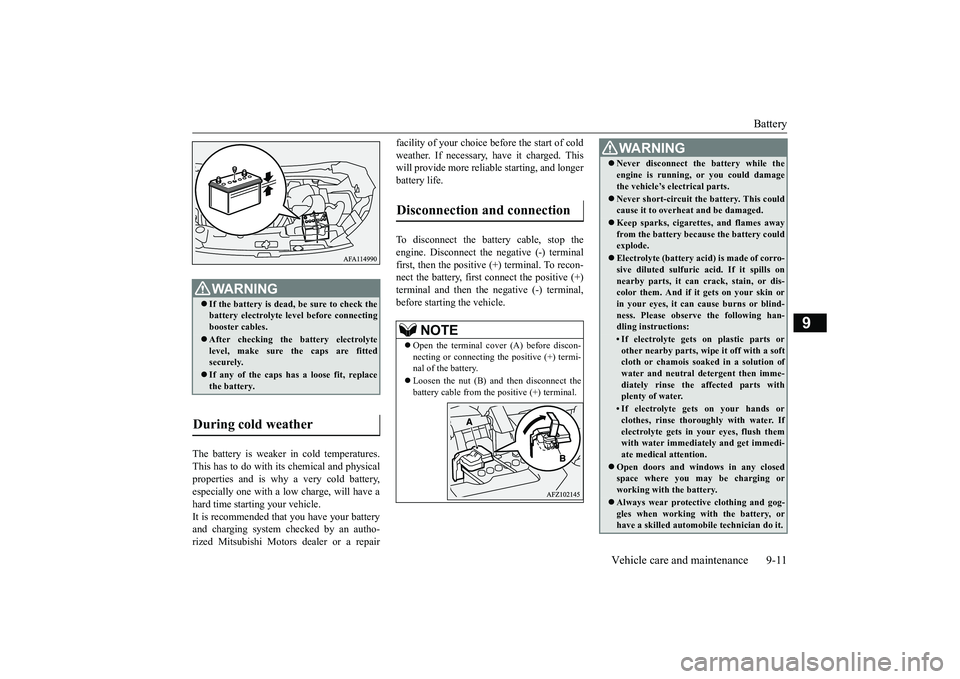
Battery
Vehicle care and maintenance 9-11
9
The battery is weaker in cold temperatures. This has to do with its chemical and physical properties and is why a very cold battery, especially one with a low charge, will have ahard time starting your vehicle. It is recommended that you have your battery and charging system checked by an autho-rized Mitsubishi Motors dealer or a repair
facility of your choice before the start of cold weather. If necessary, have it charged. This will provide more reliable starting, and longer battery life. To disconnect the battery cable, stop the engine. Disconnect the negative (-) terminalfirst, then the positive (+) terminal. To recon-nect the battery, first connect the positive (+) terminal and then the negative (-) terminal, before starting the vehicle.
WA R N I N G If the battery is dead, be sure to check the battery electrolyte level before connecting booster cables. After checking the battery electrolyte level, make sure the caps are fitted securely. If any of the caps has a loose fit, replace the battery.
During cold weather
Disconnection and connection
NOTE
Open the terminal cover (A) before discon- necting or connecting the positive (+) termi- nal of the battery. Loosen the nut (B) and then disconnect the battery cable from the positive (+) terminal.
WA R N I N G Never disconnect the battery while the engine is running, or you could damage the vehicle’s electrical parts. Never short-circuit the battery. This could cause it to overheat and be damaged. Keep sparks, cigarettes, and flames away from the battery because the battery could explode. Electrolyte (battery acid) is made of corro- sive diluted sulfuric
acid. If it spills on
nearby parts, it can crack, stain, or dis-color them. And if it gets on your skin or in your eyes, it can cause burns or blind- ness. Please observe the following han-dling instructions:• If electrolyte gets on plastic parts orother nearby parts, wi
pe it off with a soft
cloth or chamois soaked in a solution of water and neutral detergent then imme-diately rinse the affected parts with plenty of water.• If electrolyte gets on your hands orclothes, rinse thoroughly with water. If electrolyte gets in your eyes, flush themwith water immediately and get immedi- ate medical attention.
Open doors and windows in any closed space where you may be charging or working with the battery. Always wear protective clothing and gog- gles when working with the battery, or have a skilled automobile technician do it.
BK0266800US.bo
ok 11 ページ 2018年6月27日 水曜日 午後5時6分
Page 373 of 423
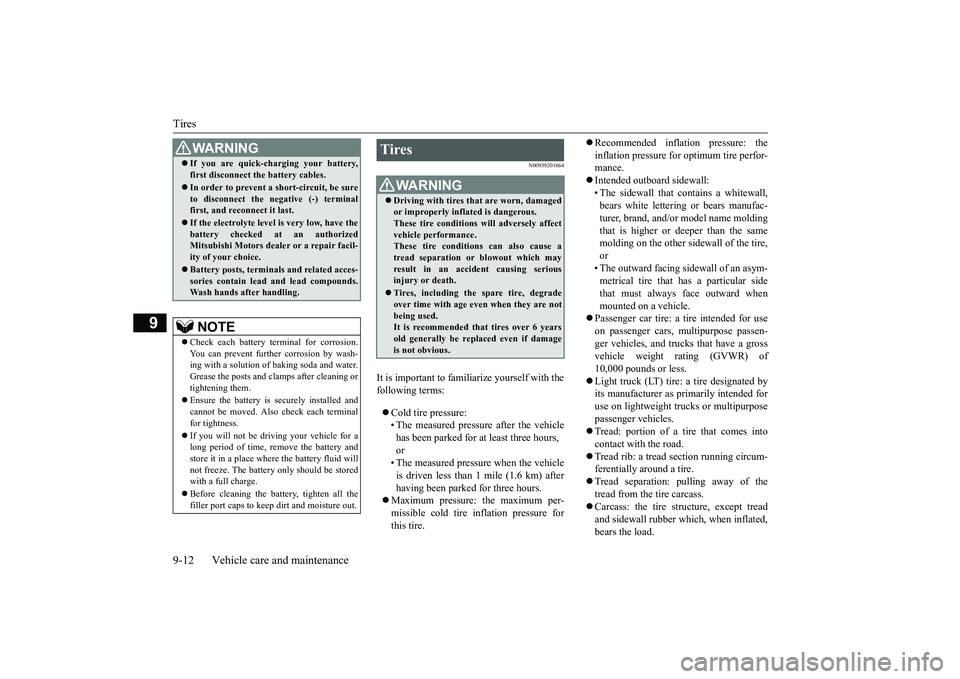
Tires 9-12 Vehicle care and maintenance
9
N00939201664
It is important to familiarize yourself with the following terms: Cold tire pressure: • The measured pressure after the vehicle has been parked for at least three hours,or • The measured pressure when the vehicle is driven less than 1 mile (1.6 km) afterhaving been parked for three hours.
Maximum pressure: the maximum per- missible cold tire inflation pressure forthis tire.
Recommended inflation pressure: the inflation pressure for optimum tire perfor- mance. Intended outboard sidewall: • The sidewall that contains a whitewall, bears white lettering or bears manufac- turer, brand, and/or model name moldingthat is higher or deeper than the same molding on the other sidewall of the tire, or• The outward facing sidewall of an asym-metrical tire that has a particular side that must always face outward when mounted on a vehicle.
Passenger car tire: a tire intended for use on passenger cars,
multipurpose passen-
ger vehicles, and trucks that have a grossvehicle weight rating (GVWR) of 10,000 pounds or less. Light truck (LT) tire: a tire designated by its manufacturer as primarily intended for use on lightweight trucks or multipurpose passenger vehicles. Tread: portion of a tire that comes into contact with the road. Tread rib: a tread section running circum- ferentially around a tire. Tread separation: pulling away of the tread from the tire carcass. Carcass: the tire structure, except tread and sidewall rubber which, when inflated, bears the load.
If you are quick-charging your battery, first disconnect the battery cables. In order to prevent a short-circuit, be sure to disconnect the negative (-) terminalfirst, and reconnect it last. If the electrolyte level is very low, have the battery checked at an authorized Mitsubishi Motors dealer or a repair facil- ity of your choice. Battery posts, terminals and related acces- sories contain lead and lead compounds.Wash hands after handling.NOTE
Check each battery terminal for corrosion. You can prevent further corrosion by wash- ing with a solution of baking soda and water.Grease the posts and clamps after cleaning or tightening them. Ensure the battery is securely installed and cannot be moved. Also check each terminal for tightness. If you will not be driv
ing your vehicle for a
long period of time, remove the battery and store it in a place where the battery fluid will not freeze. The battery only should be storedwith a full charge. Before cleaning the battery, tighten all the filler port caps to keep dirt and moisture out.WA R N I N G
Tires
WA R N I N G Driving with tires that are worn, damaged or improperly inflated is dangerous. These tire conditions will adversely affect vehicle performance.These tire conditions can also cause a tread separation or blowout which may result in an accident causing seriousinjury or death. Tires, including the spare tire, degrade over time with age even when they are not being used. It is recommended that tires over 6 yearsold generally be replaced even if damage is not obvious.
BK0266800US.bo
ok 12 ページ 2018年6月27日 水曜日 午後5時6分
Page 374 of 423
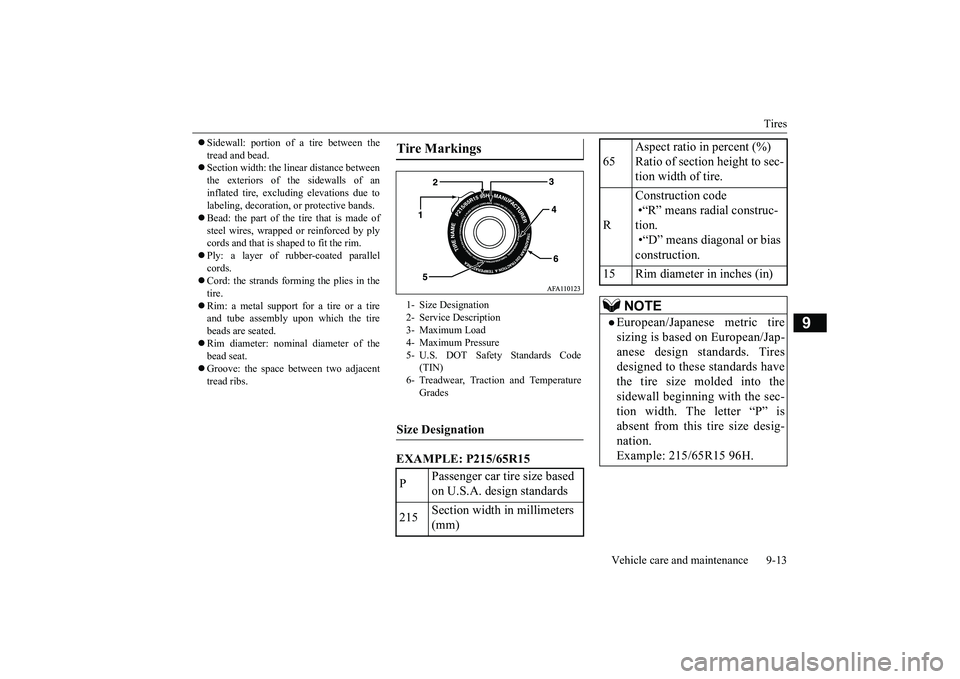
Tires
Vehicle care and maintenance 9-13
9
Sidewall: portion of a tire between the tread and bead. Section width: the li
near distance between
the exteriors of the sidewalls of aninflated tire, excluding elevations due to labeling, decoration, or protective bands. Bead: the part of the tire that is made of steel wires, wrapped or reinforced by ply cords and that is shaped to fit the rim. Ply: a layer of rubber-coated parallel cords. Cord: the strands forming the plies in the tire. Rim: a metal support for a tire or a tire and tube assembly upon which the tire beads are seated. Rim diameter: nominal diameter of the bead seat. Groove: the space between two adjacent tread ribs.
EXAMPLE: P215/65R15Tire Markings 1- Size Designation 2- Service Description 3- Maximum Load4- Maximum Pressure 5- U.S. DOT Safety Standards Code
(TIN)
6- Treadwear, Traction and Temperature
Grades
Size Designation P
Passenger car tire size based on U.S.A. design standards
215
Section width in millimeters (mm)
65
Aspect ratio in percent (%) Ratio of section height to sec- tion width of tire.
R
Construction code •“R” means radial construc- tion. •“D” means diagonal or bias construction.
15 Rim diameter in inches (in)
NOTE
European/Japanese metric tire sizing is based on European/Jap-anese design standards. Tires designed to these standards have the tire size molded into thesidewall beginning with the sec- tion width. The letter “P” is absent from this tire size desig-nation. Example: 215/65R15 96H.
BK0266800US.bo
ok 13 ページ 2018年6月27日 水曜日 午後5時6分
Page 375 of 423
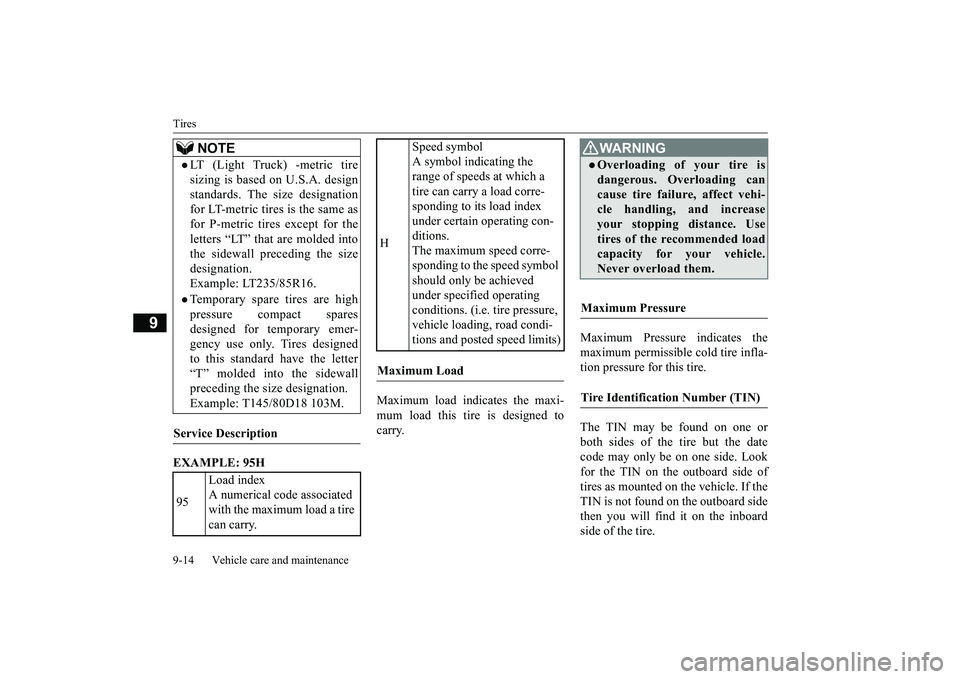
Tires 9-14 Vehicle care and maintenance
9
EXAMPLE: 95H
Maximum load indicates the maxi- mum load this tire is designed to carry.
Maximum Pressure indicates the maximum permissible cold tire infla- tion pressure for this tire. The TIN may be found on one or both sides of the tire but the date code may only be on one side. Look for the TIN on the outboard side of tires as mounted on the vehicle. If the TIN is not found on the outboard sidethen you will find it on the inboard side of the tire.
LT (Light Truck) -metric tiresizing is based on U.S.A. design standards. The size designationfor LT-metric tires is the same as for P-metric tires except for the letters “LT” that are molded intothe sidewall preceding the size designation. Example: LT235/85R16.Temporary spare tires are highpressure compact sparesdesigned for temporary emer- gency use only. Tires designed to this standard have the letter“T” molded into the sidewall preceding the size designation. Example: T145/80D18 103M.
Service Description 95
Load index A numerical code associated with the maximum load a tire can carry.NOTE
H
Speed symbol A symbol indicating the range of speeds at which a tire can carry a load corre-sponding to its load index under certain operating con- ditions.The maximum speed corre- sponding to the speed symbol should only be achieved under specified operating conditions. (i.e. tire pressure, vehicle loading, road condi-tions and posted speed limits)
Maximum Load
WA R N I N GOverloading of your tire is dangerous. Overloading can cause tire failure, affect vehi-cle handling, and increase your stopping distance. Use tires of the recommended loadcapacity for your vehicle. Never overload them.
Maximum Pressure Tire Identification Number (TIN)
BK0266800US.bo
ok 14 ページ 2018年6月27日 水曜日 午後5時6分
Page 377 of 423
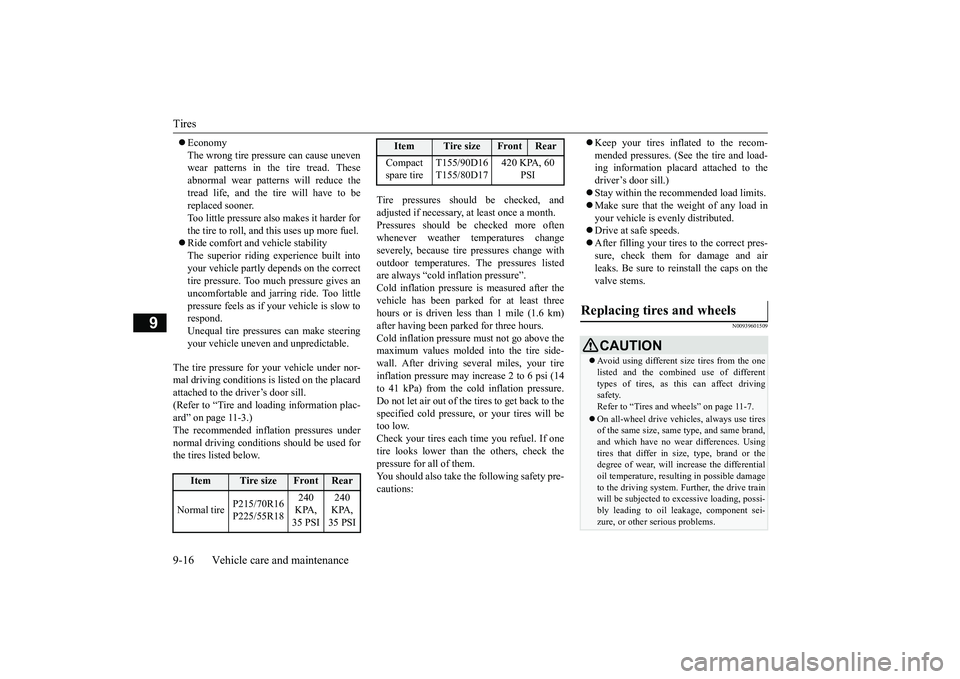
Tires 9-16 Vehicle care and maintenance
9
Economy The wrong tire pressure can cause uneven wear patterns in the tire tread. These abnormal wear patterns will reduce thetread life, and the tire will have to be replaced sooner. Too little pressure also makes it harder forthe tire to roll, and this uses up more fuel. Ride comfort and vehicle stability The superior riding experience built intoyour vehicle partly depends on the correcttire pressure. Too much pressure gives an uncomfortable and jarring ride. Too little pressure feels as if your vehicle is slow torespond. Unequal tire pressures can make steering your vehicle uneven and unpredictable.
The tire pressure for your vehicle under nor- mal driving conditions is listed on the placard attached to the driver’s door sill. (Refer to “Tire and loading information plac-ard” on page 11-3.) The recommended infl
ation pressures under
normal driving conditions should be used forthe tires listed below.
Tire pressures should be checked, and adjusted if necessary, at least once a month. Pressures should be checked more often whenever weather temperatures changeseverely, because tire pressures change with outdoor temperatures. The pressures listed are always “cold inflation pressure”.Cold inflation pressure is measured after the vehicle has been parked for at least three hours or is driven less than 1 mile (1.6 km)after having been parked for three hours.Cold inflation pressure must not go above the maximum values molded into the tire side- wall. After driving several miles, your tireinflation pressure may increase 2 to 6 psi (14 to 41 kPa) from the cold inflation pressure. Do not let air out of the tires to get back to thespecified cold pressure, or your tires will be too low. Check your tires each time you refuel. If onetire looks lower than the others, check the pressure for all of them. You should also take the following safety pre-cautions:
Keep your tires inflated to the recom- mended pressures. (See the tire and load- ing information placard attached to the driver’s door sill.) Stay within the recommended load limits. Make sure that the weight of any load in your vehicle is evenly distributed. Drive at safe speeds. After filling your tires to the correct pres- sure, check them for damage and airleaks. Be sure to reinstall the caps on thevalve stems.
N00939601509
Item
Tire size
Front
Rear
Normal tire
P215/70R16 P225/55R18
240 KPA, 35 PSI
240 KPA, 35 PSI
Compact spare tire
T155/90D16 T155/80D17
420 KPA, 60
PSI
Item
Tire size
Front
Rear
Replacing tires and wheels
CAUTION Avoid using different si
ze tires from the one
listed and the combined use of different types of tires, as this can affect drivingsafety. Refer to “Tires and wheels” on page 11-7. On all-wheel drive vehicles, always use tires of the same size, same type, and same brand, and which have no wear differences. Usingtires that differ in size, type, brand or the degree of wear, will increase the differential oil temperature, resulting in possible damage to the driving system. Further, the drive train will be subjected to excessive loading, possi-bly leading to oil leakage, component sei- zure, or other serious problems.
BK0266800US.bo
ok 16 ページ 2018年6月27日 水曜日 午後5時6分
Page 378 of 423
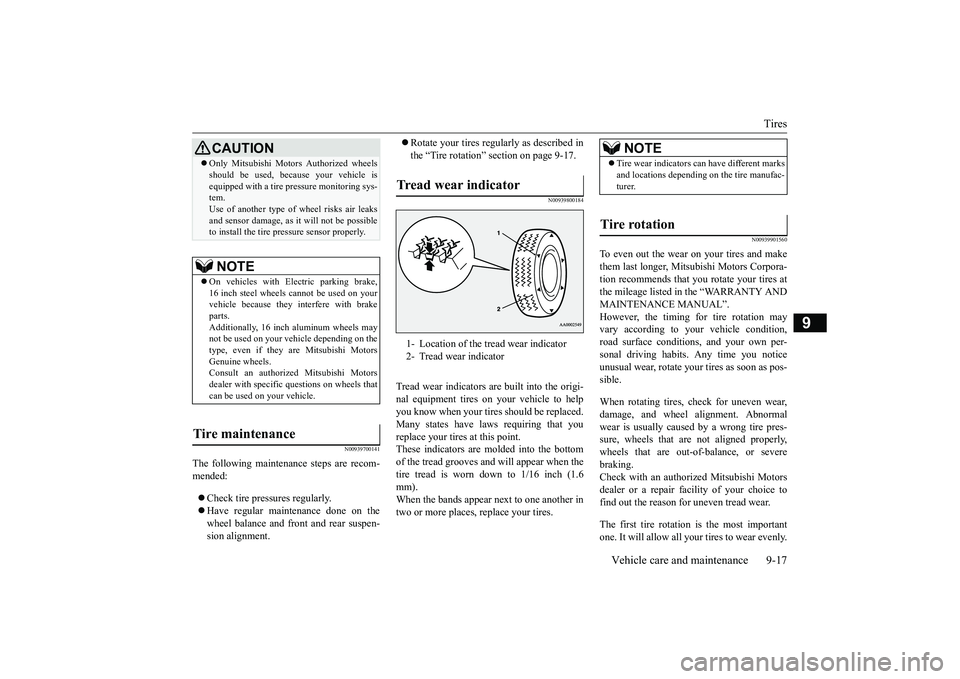
Tires
Vehicle care and maintenance 9-17
9
N00939700141
The following maintenance steps are recom- mended: Check tire pressures regularly. Have regular maintenance done on the wheel balance and front and rear suspen-sion alignment.
Rotate your tires regularly as described in the “Tire rotation” section on page 9-17.
N00939800184
Tread wear indicators are built into the origi- nal equipment tires on your vehicle to help you know when your tires should be replaced.Many states have laws requiring that you replace your tires at this point. These indicators are molded into the bottomof the tread grooves and will appear when the tire tread is worn down to 1/16 inch (1.6 mm).When the bands appear next to one another in two or more places, replace your tires.
N00939901560
To even out the wear on your tires and make them last longer, Mitsubishi Motors Corpora-tion recommends that you rotate your tires at the mileage listed in the “WARRANTY AND MAINTENANCE MANUAL”.However, the timing for tire rotation may vary according to your vehicle condition, road surface conditions, and your own per-sonal driving habits. Any time you notice unusual wear, rotate your tires as soon as pos- sible. When rotating tires, check for uneven wear, damage, and wheel alignment. Abnormal wear is usually caused by a wrong tire pres- sure, wheels that are not aligned properly,wheels that are out-of-balance, or severe braking. Check with an authorized Mitsubishi Motorsdealer or a repair faci
lity of your choice to
find out the reason for uneven tread wear. The first tire rotation is the most important one. It will allow all your tires to wear evenly.
Only Mitsubishi Motors Authorized wheels should be used, because your vehicle is equipped with a tire pressure monitoring sys- tem. Use of another type of wheel risks air leaksand sensor damage, as it will not be possible to install the tire pressure sensor properly.NOTE
On vehicles with Electric parking brake, 16 inch steel wheels cannot be used on yourvehicle because they interfere with brake parts. Additionally, 16 inch aluminum wheels maynot be used on your vehicle depending on the type, even if they are Mitsubishi Motors Genuine wheels.Consult an authorized Mitsubishi Motors dealer with specific questions on wheels that can be used on your vehicle.
Tire maintenance
CAUTION
Tread wear indicator 1- Location of the tread wear indicator 2- Tread wear indicator
NOTE
Tire wear indicators can have different marks and locations depending on the tire manufac- turer.
Tire rotation
BK0266800US.bo
ok 17 ページ 2018年6月27日 水曜日 午後5時6分
Page 381 of 423
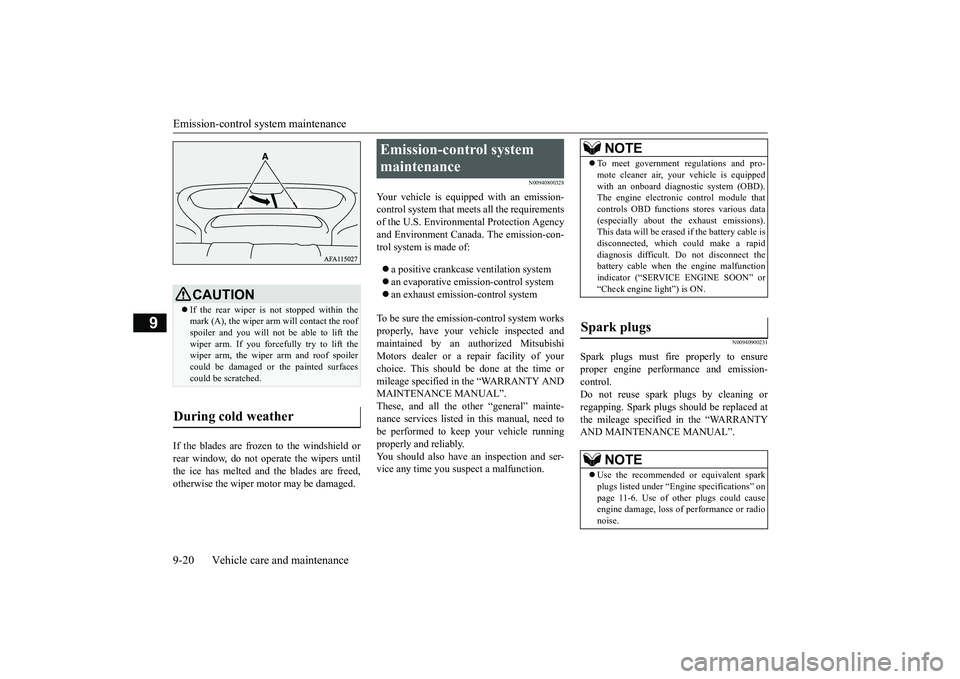
Emission-control system maintenance 9-20 Vehicle care and maintenance
9
If the blades are frozen to the windshield or rear window, do not operate the wipers until the ice has melted and the blades are freed,otherwise the wiper motor may be damaged.
N00940800328
Your vehicle is equipped with an emission-control system that meets all the requirementsof the U.S. Environmental Protection Agency and Environment Canada. The emission-con- trol system is made of: a positive crankcase ventilation system an evaporative emission-control system an exhaust emission-control system
To be sure the emission-control system works properly, have your vehicle inspected and maintained by an authorized MitsubishiMotors dealer or a repair facility of your choice. This should be done at the time or mileage specified in the “WARRANTY ANDMAINTENANCE MANUAL”. These, and all the other “general” mainte- nance services listed in this manual, need tobe performed to keep your vehicle running properly and reliably. You should also have an inspection and ser-vice any time you suspect a malfunction.
N00940900231
Spark plugs must fire properly to ensureproper engine performance and emission-control. Do not reuse spark plugs by cleaning or regapping. Spark plugs should be replaced atthe mileage specified in the “WARRANTY AND MAINTENANCE MANUAL”.
CAUTION If the rear wiper is not stopped within the mark (A), the wiper arm will contact the roofspoiler and you will not be able to lift the wiper arm. If you forcefully try to lift the wiper arm, the wiper arm and roof spoilercould be damaged or the painted surfaces could be scratched.
During cold weather
Emission-control system maintenance
NOTE
To meet government regulations and pro- mote cleaner air, your vehicle is equipped with an onboard diagnostic system (OBD). The engine electronic control module that controls OBD functions stores various data(especially about the exhaust emissions). This data will be erased if the battery cable is disconnected, which could make a rapiddiagnosis difficult. Do not disconnect the battery cable when the engine malfunction indicator (“SERVICE ENGINE SOON” or“Check engine light”) is ON.
Spark plugs
NOTE
Use the recommended or equivalent spark plugs listed under “Engine specifications” on page 11-6. Use of other plugs could cause engine damage, loss of performance or radionoise.
BK0266800US.bo
ok 20 ページ 2018年6月27日 水曜日 午後5時6分